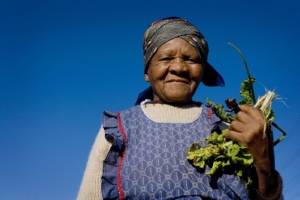Models for Eldercare in Sub-Saharan Africa
 The world is experiencing rapid demographic aging. In sub-Saharan Africa, a population of 165 million people above the age of 65 is expected by the year 2050, a number more than three times greater than today’s demographics in the region. The care needs of the elderly are much greater in developing countries than in developed countries. However, the WHO works to create sustainable, organized, affordable and accessible long-term care infrastructure that will protect the rights and dignity of vulnerable elderly people. Implementation of universal health coverage, which will make quality eldercare feasible, is its biggest priority in this regard.
The world is experiencing rapid demographic aging. In sub-Saharan Africa, a population of 165 million people above the age of 65 is expected by the year 2050, a number more than three times greater than today’s demographics in the region. The care needs of the elderly are much greater in developing countries than in developed countries. However, the WHO works to create sustainable, organized, affordable and accessible long-term care infrastructure that will protect the rights and dignity of vulnerable elderly people. Implementation of universal health coverage, which will make quality eldercare feasible, is its biggest priority in this regard.
The most successful models for eldercare in sub-Saharan Africa are collaborative and meet the rights, needs and preferences of individuals while encouraging their purposeful participation in society and their independence to the greatest extent possible. Oftentimes, this effective care allows for the elderly to remain in the home of a relative but with in-home care visits and access to a variety of supportive programs that meet their basic needs and also combat loneliness and isolation. A few innovative programs in sub-Saharan Africa meet the long-term care needs of the elderly. The study of these models facilitates their recreation for greater numbers of elderly citizens.
Examples of Successful Models for Eldercare in sub-Saharan Africa
- Ghana: Care for the Aged Foundation provides organized, in-home care visits and assistance with personal care errands. Volunteer workers receive free health care in exchange for their service. Trust has grown in the community for this type of care and there is a long waitlist to participate.
- Kenya: Private Nursing Agency [name protected per WHO policy] is a private company also providing individualized, in-home care from professionals. This efficient model is growing in popularity, but it is inaccessabile for those without insurance due to the cost.
- South Africa: Rand Aid is a nonprofit organization with a retirement village model. Residents have security, a high quality of life and care as needed. The returned equity for their spot in the village (as with a condo as opposed to non-returned rent or nursing home expenses) draws people in. Care focuses on freedom of choice and autonomy, translating to the best quality of life.
- Tanzania: HelpAge International works to improve access to in-home health care services to combat symptoms of poverty and alleviate long-term illnesses. HelpAge implements the Better Health for Older People in Africa program funded through U.K. aid. The program is widespread, individualized and collaborative with families. The program assists physical, emotional, spiritual, social and even the economic wellbeing of the clients.
These programs have the following characteristics in common:
- Involvement of family members in plan implementation
- Taking into consideration the preferences of the elderly person in care
- Adequate training of the caregivers
- Integration of comprehensive healthcare services
- Equitable access
- Quality of conditions for care providers
- Financial sustainability of programs
Filial Piety in sub-Saharan Africa
Currently, in sub-Saharan Africa, tradition and societal norms, as well as the lack of large-scale organized infrastructure, dictates that children of the elderly carry out the majority of eldercare in their homes, known as filial piety. The overwhelming burden of long-term care falls on girls and women. Most elderly requiring long-term care (those who no longer live independently) receive that care in an unregulated manner. This strain can prolong the cycle of poverty for far too many households.
In addition, the quality of care can be highly inconsistent leaving room for neglect and lack of basic needs being met. Girls and women who care for the elderly may miss out on education or employment opportunities because of this expectation. Furthermore, their own physical and mental health may suffer.
Continued research will increase understanding of the dynamics of eldercare globally. A Health and Retirement Study in the U.S. has expanded to several international sister studies and the World Health Organization is conducting a longitudinal study collecting data on adult health and aging.
What Can Be Done?
In order to meet the needs of the elderly in sub-Saharan Africa and establish integrated long-term care systems in the decades to come, several steps are needed according to the WHO:
- A comprehensive understanding of how people age and what their needs are.
- Analysis of deficits in current care models as well as the burdens placed on others.
- Close mapping of successful models and how to replicate them.
- Sharing of information and best practices cross-culturally and cross-nationally.
- Nurturing cultural acceptance of effective models that may differ from current practices.
- Coordinating and establishing national efforts, including funding; build infrastructure. Training and monitoring of caregivers are essential to this structure.
– Susan Niz
Photo: Wikimedia
